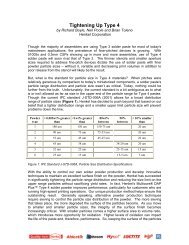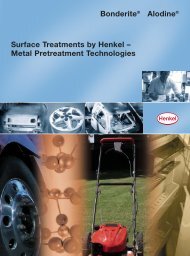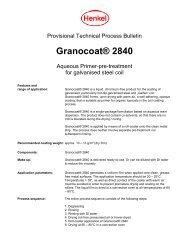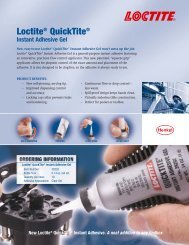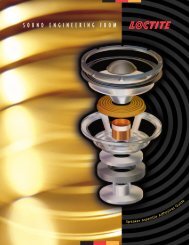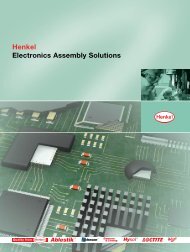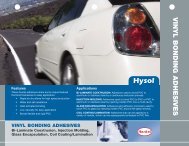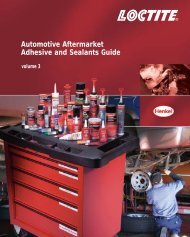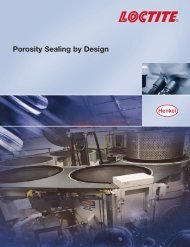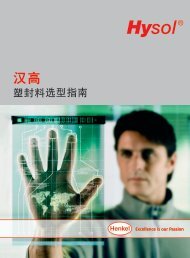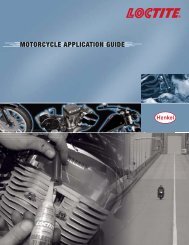equipment sourcebook - Loctite.ph
equipment sourcebook - Loctite.ph
equipment sourcebook - Loctite.ph
- No tags were found...
Create successful ePaper yourself
Turn your PDF publications into a flip-book with our unique Google optimized e-Paper software.
Meter Mix Dispensing SystemsPump Selector GuidesFixed Ratio Systems for Meter Mix 1000, 2000 and 3000 Dispense SystemsAll <strong>Loctite</strong>® brand MMD machines include two (2) standard pump sizes: 8, 10, 15, 20 and 25 mm.CHART 1 - Fixed Ratio Pump Diameter Configuration and Corresponding Mix RatioHIGH VOLUME PUMP (mm) 8.000 9.500 10.000 11.000 12.000 13.000 14.000 15.000 20.000 25.000LOW VOLUME PUMP (mm) Output CCs 1.277 1.800 1.995 2.414 2.873 3.371 3.910 4.489 7.980 12.4688.000 1.277 1.00 1.41 1.56 1.89 2.25 2.64 3.06 3.52 6.25 9.779.500 1.800 1.00 1.11 1.34 1.60 1.87 2.17 2.49 4.43 6.9310.000 1.995 1.00 1.21 1.44 1.69 1.96 2.25 4.00 6.2511.000 2.414 1.00 1.19 1.40 1.62 1.86 3.31 5.1712.000 2.873 1.00 1.17 1.36 1.56 2.78 4.3413.000 3.371 1.00 1.16 1.33 2.37 3.7014.000 3.910 1.00 1.15 2.04 3.1915.000 4.489 1.00 1.78 2.7820.000 7.980 1.00 1.5625.000 12.468 1.00Pump sizes = WHITE; Maximum output per single pump = BLUE; Volumetric mix ratio (high volume component/low volume component) = BLACKDISPENSING Two-Part VolumetricDispensingMeter Mix SystemsSELECTION PROCESS1. Determine the adhesive shot volume required per part in cubic centimeters (cc’s; same as ml’s), from production requirements.2. From adhesive technical data sheet, determine the adhesive volumetric mix ratio(high volume component/low volume component).3. Review the blue maximum outputs for a volume which is 50% to 90% of the maximum output volume of the combined pumpsize configuration. Be sure to combine a high volume and low volume pump for the corresponding maximum output volume ofthe combined pumps, see example 1.a. If the adhesive shot volume required is greater than that of the maximum possible output of the configurations, divide the required shotvolume by the smallest number which makes the required shot volume less than the maximum possible output for that configuration.Then repeat step 4. The divisor is the number of cycles the machine must perform to meet the required shot volume, see example 2.b. Compare the maximum output volume of the combined pump configuration to the white mix ratio for that combination of pumpsizes. If the corresponding mix ratio does not exactly match that of the adhesive, review the chart for other alternatives, or specifyone pump from the chart, along with a Custom pump size, which will yield the exact pump configuration required for the adhesivesmix ratio, see example 2 and see custom pump volume calculation example below**.EXAMPLE #1 FIXED RATIO –STANDARD PUMP SIZES APPLYHigh volume = 1 Low volume = 1Mix ratio = 1/1 = 1Per part shot size = 6 cc (6 ml)High volume pump = 15 mm Low volume pump = 15 mmVolumetric mix ratio = 1/1Maximum pump combination output = 8.978 cc(6 cc / 8.978 cc) x 100% = 67% - ‡ o.k.Recommended pump configuration = 15 mm/15 mm15 mm pumps are standard sizes; therefore no custom pump fee is required.** CUSTOM PUMP VOLUME CALCULATION – π x (Cylinder Radius) 2EXAMPLE #2 FIXED RATIO –1 CUSTOM PUMP SIZE AND 2 CYCLES REQUIRED FOR REQUIRED SHOT SIZEHigh volume = 2 Low volume = 1 Mix ratio = 2/1 = 2Per part shot size = 22.5 cc (22.5 ml)Maximum output volume of 2:1 combination ~ 18.7 cc with a25 mm/17.675 mm pump configurationPer part shot size divided by 2 = 11.25 cc (11.25 ml)High volume pump = 25 mm Low volume pump = 17.675 mmVolumetric mix ratio = 2/1Maximum pump combination output = 18.7 cc(11.25 cc/18.7 cc) x 100% = 60% - ‡ o.k.Two (2) shots per part are needed to obtain 22.5 cc per part shot size requirement.Recommended pump configuration = 25 mm / 17.675 mm25 mm pump is standard; 17.675 mm pump is special.One custom pump sizing fee applies.TO CALCULATE PUMP VOLUMES FOR CUSTOM PUMP SIZES – USE THE FOLLOWING EXAMPLE (Note: All pump lengths are 2.54 cm)Volume of cylinder = (π x (Cylinder Radius) 2 x Cylinder Length) *(NOTE: Need to convert pump diameter to radius and pump size from mm to cm)*For a 16 mm diameter cylinder: Cylinder Radius = 16 mm /2 = 8 mm or 0.80 cm; Cylinder Length = 2.54 cm; π = 3.14159Volume of 16 mm Pump = (3.14159) x (0.80 cm) 2 x 2.54 cm = 5.107 ccFor additional information and the full line of <strong>equipment</strong>, visit www.<strong>equipment</strong>.loctite.com.41




